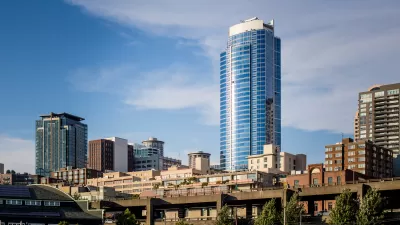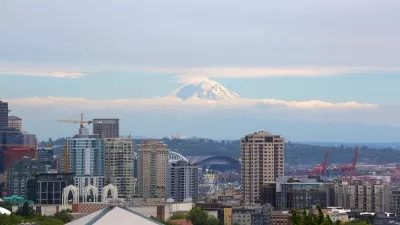To preserve views, zoning rules from 2006 require adequate distance between residential towers of a certain height. As developers chafe against the restriction, residents still worry they'll be left facing a wall.

Another symptom of Seattle's success: limited access to a decent view. Condos boasting picture-window vistas a decade ago lose their allure when an even taller residential tower goes up 20 feet away.
Seattle has taken steps to prevent that from happening. "The city's tower-spacing rule, which governs a large swath of downtown, was adopted nearly a decade ago to preserve views and daylight in an increasingly dense downtown [...] When the city overhauled the zoning code in 2006, it allowed developers to build denser, higher towers in downtown's mixed-use areas."
"To prevent streets from becoming walled corridors that block out light and views, and make pedestrians feel like they're in a wind tunnel, the city required that new towers over 160 feet high be 60 to 200 feet away, depending on the part of downtown, from other existing or permitted ones." Unfortunately, or fortunately, depending on how you look at it, this rule puts adjacent developers into competition for the permit to build higher. "Even small delays by either side can lead to being second in line for a tower permit and huge lost opportunities [...]"
Still, the tower-spacing rule enjoys public support. "Some residents of other downtown areas where the tower-spacing rules don't apply wish they had such restrictions. They say they live in fear of having a tower built a stone's throw from their window." To address those fears, some developers are experimenting with the podium-style developments (wide base, often with retail, and a thin, glassy tower on top) that have seen success in Vancouver.
FULL STORY: Rules preserving city views set up clash among towers competing to be first, biggest

Maui's Vacation Rental Debate Turns Ugly
Verbal attacks, misinformation campaigns and fistfights plague a high-stakes debate to convert thousands of vacation rentals into long-term housing.

Planetizen Federal Action Tracker
A weekly monitor of how Trump’s orders and actions are impacting planners and planning in America.

Chicago’s Ghost Rails
Just beneath the surface of the modern city lie the remnants of its expansive early 20th-century streetcar system.

Bend, Oregon Zoning Reforms Prioritize Small-Scale Housing
The city altered its zoning code to allow multi-family housing and eliminated parking mandates citywide.

Amtrak Cutting Jobs, Funding to High-Speed Rail
The agency plans to cut 10 percent of its workforce and has confirmed it will not fund new high-speed rail projects.

LA Denies Basic Services to Unhoused Residents
The city has repeatedly failed to respond to requests for trash pickup at encampment sites, and eliminated a program that provided mobile showers and toilets.
Urban Design for Planners 1: Software Tools
This six-course series explores essential urban design concepts using open source software and equips planners with the tools they need to participate fully in the urban design process.
Planning for Universal Design
Learn the tools for implementing Universal Design in planning regulations.
planning NEXT
Appalachian Highlands Housing Partners
Mpact (founded as Rail~Volution)
City of Camden Redevelopment Agency
City of Astoria
City of Portland
City of Laramie




























